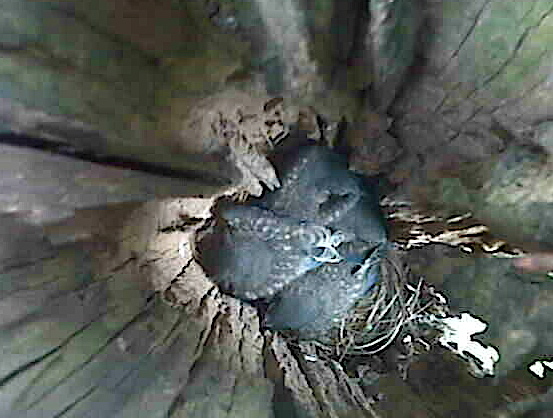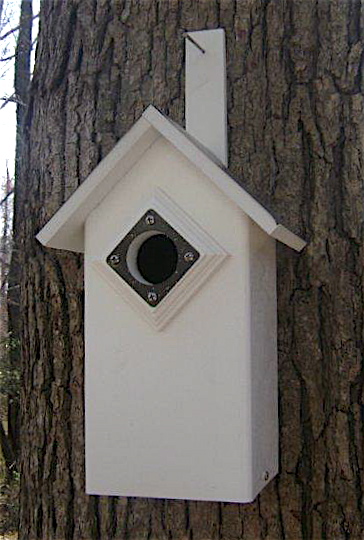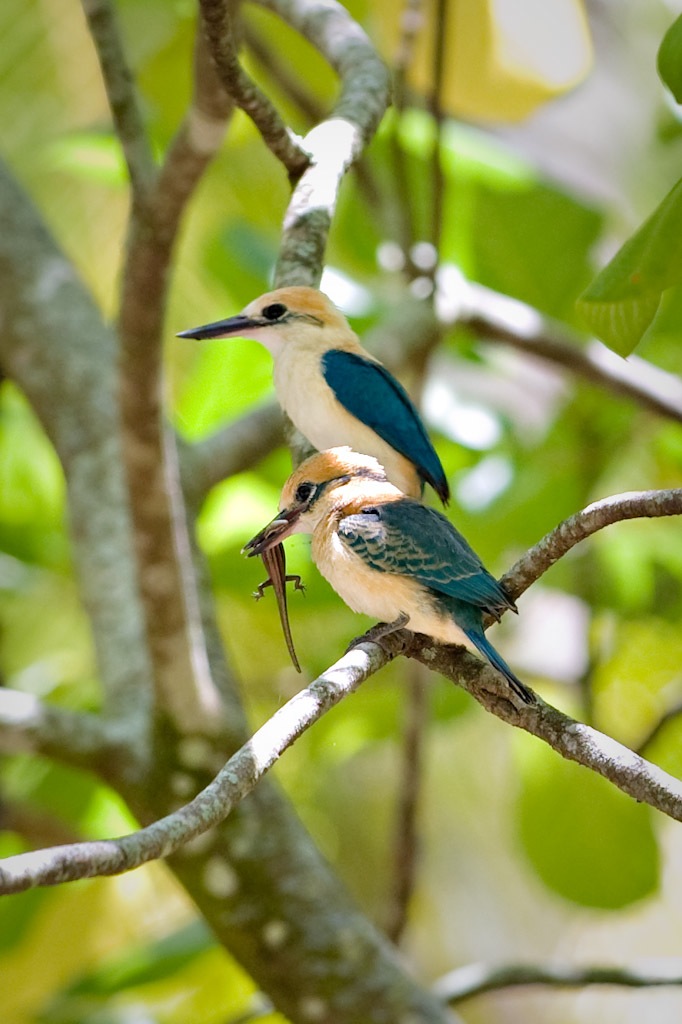-
some cool blue bird houses to last a lifetime
baby bluebirds grow up in a fence post at the farm With a severe shortage in natural nesting places, bluebirds will appreciate decent diggs to nest and raise their young. With increasing development from strip malls to subdivisions snuffing out habitat, competition from non-native species also plays a huge part in this shortage of nest spots.
You can provide proper housing in high style, with blue bird houses that will never rot, fade or warp with weather and time. More than just wood, materials like vinyl, ceramics and stoneware make for fantastic blue bird houses that are handcrafted to last a lifetime. This Vinyl Cottage Bluebird House happens to be NABS (North American Bluebird Society) approved. Complete with a metal predator guard, it helps protect eggs and nestlings from predators like cats, raccoons, and larger birds.
On a more artistic note, handcrafted stoneware blue bird houses can provide an interesting focal point in the landscape, while providing a proper nest site for blue birds. Stoneware is also inert, meaning it will not rot, is totally insect proof and guarantees to be around for a lifetime.
Help bluebirds thrive and flourish by erecting blue bird houses in your yard. You can entice them with suet and heated birdbaths in winter, and of course their favorite food any time of year… live mealworms! If you’re lucky enough to have more than one successful brood, it’s a real joy and pleasure to watch juveniles from the first brood help raise the new chicks and teach them to hunt.
-
TV ICON BOB BARKER OFFERS $100,000 TO CITY OF EDMONTON!
A serious situation is unfolding at the Edmonton Valley Zoo with Lucy the sick Asian elephant and Bob Barker’s generous offer of $100,000 that would pay to bring in world-renowned elephant experts to properly examine and diagnose Lucy who is dire need of specialist care. Unless the City accepts Bob Barker’s offer to pay for a second opinion for Lucy, she remains a hostage in solitary confinement. The goal is to prolong Lucy’s life providing her with expert specialist care and eventually moving her to an animal sanctuary in the U.S.
Bob Barker has offered the City $100,000 if they allow animal welfare organizations to bring in outside elephant veterinary experts to properly diagnose Lucy’s current condition. This important medical intervention will be able to determine her ultimate fate: obtain a needed second opinion about her condition and fitness to travel or allow her condition to worsen which could lead to her potential demise.
Bob Barker and animal welfare organizations are urging the Mayor of Edmonton to accept the $100,000 grant and agree to a proper second opinion and the very best in veterinary medicine. This is the right thing for Lucy, the City, the world and countless other zoo animals.
Please help publicize Lucy’s plight and be voice for those who can’t speak for themselves, they count on us to help. Unfortunately, Lucy is not the only captive elephant that is suffering without necessary care and treatment.
PRESS RELEASE:
Television icon Bob Barker is prepared to contribute $100,000.00 to the city of Edmonton to use as the city choose if the city will agree to allow independent elephant experts, selected by Zoocheck Canada and Performing Animal Welfare Society, to come to Edmonton and examine Lucy, an elephant in the Edmonton Valley Zoo, who has lived in chronic physical distress for decades, according to the Zoo’s own medical records secured under the Freedom of Information Act.“It’s crucial that Lucy’s condition be accurately diagnosed before her health deteriorates further,” said Barker. “It is indefensible that Lucy has been forced to live in misery for all these years.”
A number of animal protection organizations, including Zoocheck Canada, believe that Lucy’s health problems will lead to her death unless her condition is correctly diagnosed and proper remedial treatment is administered immediately.
Barker made the offer upon hearing that Lucy’s “respiratory condition” has still not been diagnosed and that Lucy continues to be in distress 18 months after reports of her ill health began circulating.
For several years, Edmonton Valley Zoo management have said they cannot move Lucy because of a mysterious “breathing problem,” but they have been unable to diagnose the source of the problem or to provide any treatment to relieve its symptoms. Meanwhile Lucy’s health and welfare continue to be of concern with her weight remaining excessively high and her foot problems (the leading cause of death in captive elephants) unresolved. On top of that, industry standards state that elephants should never be kept in groups of less than three and Lucy is all alone.
On January 13, 2011 the Edmonton Humane Society (EHS) directed Valley Zoo management to diagnose and treat Lucy’s respiratory illness but the zoo and their consultants have made little, if any, progress to date.
“I sincerely hope the City of Edmonton will allow outside experts to help Lucy so that her suffering can be ended. It seems like a win-win-win scenario to me. The zoo wins, concerned citizens win, but most importantly of all, Lucy wins,” said Barker.
-
MU Researcher Works to Save One of the World’s Most Endangered Birds
COLUMBIA, Mo. — The Tuamotu Kingfisher is a multicolored, tropical bird with bright blue feathers, a dusty orange head, and a bright green back. The entire population of these birds – less than 125 – lives on one tiny island in the south Pacific, and without serious intervention, they will no longer exist. One University of Missouri researcher is trying to stop the birds’ extinction by working with farmers and residents on the island inhabited by the kingfishers.
“If we lose these birds, we lose 50,000 years of uniqueness and evolution,” said Dylan Kesler, assistant professor in fisheries and wildlife at the University of Missouri’s School of Natural Resources in the College of Agriculture, Food and Natural Resources. “Because it has lived in isolation for a very long time, it’s unlike any other bird. There is no other bird like this on the planet.”
Dylan Kesler, assistant professor in fisheries and wildlife at the University of Missouri’s School of Natural Resources in the College of Agriculture, Food and Natural Resources, is trying to stop the extinction of one bird species by working with farmers and residents on a remote island in the south pacific.
In new studies published in the journal The Auk (published by the American Ornithologists Union) and the Journal of Wildlife Management, Kesler and his team of researchers have uncovered important information to help ensure the birds’ survival and a unique way to attach radio transmitters to the birds to track them.
To survive, the kingfishers need several specific habitat characteristics:
- Hunting Perches about 5 feet off the ground – The birds hunt by “pouncing.” They watch their prey and then fall on them from hunting perches about 5 feet high. Without the perches in broadleaf trees at the appropriate height, the birds have no way to hunt.
- Exposed ground – the birds’ food consists mainly of lizards, which are easier to spot where the ground is clear of vegetation. When coconut farmers conduct intermediate burns on their land – which are hot enough to kill brush, but do not lead to widespread fires or kill the lizards – it exposes more ground and the birds can see the lizards.
- Dead trees for nesting – the birds create nests by flying into dead trees and hollowing cavities. Live trees are too hard and many farmers cut down their dead coconut trees. By encouraging farmers to leave some dead trees, the birds will continue to be able to build nests.
- Lessoning the impact of predators – cats and rats, which were introduced to the island by humans, now hunt the Tuamotu Kingfisher. By wrapping metal bands around the trees, the predators are less likely to get into the nests, but Kesler is still searching for other solutions that might alleviate the pressure on the birds.
In a separate study, Kesler also developed a “weak-link” radio harness for the birds to wear. In previous studies with different birds, scientists have reported unintentional harm to the birds after attaching radio transmitters. That harm included scratching the birds, making the birds act peculiarly and introducing infections. Using this new harness, Kesler was able to track the birds during the study, and the harness was shed within two months.
“Unfortunately, even with all our work to date, the population is still crashing,” Kesler said. “We’re seeing some turnover, but each year when we return, there are more empty territories and the population decreases. At this rate, these birds will be gone within our lifetime.”
For more information, visit: http://picra.net/tk2010/TK2010/Introduction.html
View this news release on the Web at:
http://munews.missouri.edu/news-releases/2011/0321-mu-researcher-works-to-save-one-of-the-world%e2%80%99s-most-endangered-birds/For more news, visit:
http://munews.missouri.edu/




